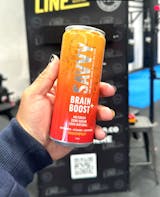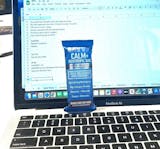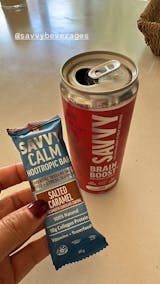
Gamma-aminobutyric acid, commonly called GABA, is an amino acid derivative that sends calming signals to your brain.
GABA (full name, Gamma-Aminobutyric acid) is an amino acid produced naturally in the brain. GABA functions as a neurotransmitter, or brain chemical, that helps your brain cells to communicate. GABA plays a role in how people experience anxiety, fear, and stress. It is involved in a wide range of suppressive and depressive activities intimate with the parasympathetic nervous system (PNS).

GABA’s main role in the body is to reduce the activity of neurons in the brain and central nervous system, which in turn has a broad range of effects on the body and mind, including increased relaxation, reduced stress, a more calm, balanced mood, alleviation of pain, and a boost to sleep.

GABA is like the brakes on a racing mind. By slowing brain activity, GABA reduces mental and physical stress, lowers anxiety, and creates a calmness of mood. GABA is an important contributor to the body’s overall mental and physical balance.

Ingredient naturally found in: Berries, Wholegrains and Brocolli
Amount used: 300mg
The following doses are based on amounts that have been investigated in scientific studies.
For, stress and anxiety: 100-200 mg and higher doses, in scientific studies. Individual dosing and length of use will vary.

To make it easy to identify all the different studies - we will highlight them for you!
| We really hope you enjoy our many years of research when formulating Savvy...
|

Adham M, A. et al. ‘Relaxation and immunity enhancement effects of gamma-aminobutyric acid (GABA) administration in humans’ in Biofactors. Volume 26, Issue 3, 2006, Pages 201-8. [Link]
“After 60 minutes of administration, GABA significantly increases alpha waves and decreases beta waves compared to water or L-theanine. These findings denote that GABA not only induces relaxation but also reduces anxiety…. GABA could work effectively as a natural relaxant and its effects could be seen within 1 hour of its administration to induce relaxation and diminish anxiety. Moreover, GABA administration could enhance immunity under stress conditions.“
Nuss, P. ‘Anxiety disorders and GABA neurotransmission: a disturbance of modulation.’ in Neuropsychiatric Disease Treatment. Volume 11, 2015, Pages 165–175. [Link]
“GABAergic neurotransmission in the amygdala is a promising candidate for modulation of anxiety-related responses. A number of lines of research in experimental animals have provided evidence for an important role of GABAergic neurotransmission in the amygdala in modulating anxiety-related behaviors.”
Hepsomali, P. et al. ‘Effects of Oral Gamma-Aminobutyric Acid (GABA) Administration on Stress and Sleep in Humans: A Systematic Review.’ in Sec. Neuroenergetics and Brain Health. Volume 14, September 17, 2020, Page 923 [Link]
“the minimum and optimum natural and biosynthetic GABA doses required for stress benefits, and (iii) the minimum and optimum natural and biosynthetic GABA doses required to affect stress reduction/relaxation peripherally and centrally.”
Liwinski, T. et al. ‘Exploring the Therapeutic Potential of Gamma-Aminobutyric Acid in Stress and Depressive Disorders through the Gut–Brain Axis’ in Biomedicines. Volume 11, Issue 12, September 2023, Pages 3128. [Link]
"Nevertheless, RCTs investigating the impact of GABA on stress, sleep, and cognition prompt exploration in the context of depression, given the frequent impairment of these domains in individuals experiencing depressive states."
Jain, P. et al. ‘Advances and Perspectives of Gamma-Aminobutyric Acid as a Bioactive Compound in Food’ in Bioactive Natural Products for Pharmaceutical Applications. December 15, 2020, Pages 819–843. [Link]
"The reason for this may be accounted for use of GABA as a supplement to treat high blood pressure, stress, and anxiety, and sleep, as well as to stimulate the body's natural growth hormone, often by athletes."
Abdou, A. et al. ‘Relaxation and immunity enhancement effects of γ-Aminobutyric acid (GABA) administration in humans’ in Biofactors. Volume 26, Issue 3, 2006, Pages 201-208. [Link]
"Electroencephalograms (EEG) were obtained after 3 tests on each volunteer as follows: intake only water, GABA, or L-theanine. After 60 minutes of administration, GABA significantly increases alpha waves and decreases beta waves compared to water or L-theanine. These findings denote that GABA not only induces relaxation but also reduces anxiety."
Northoff, G. et al. ‘GABA concentrations in the human anterior cingulate cortex predict negative BOLD responses in fMRI’ in Nature Neuroscience. Volume 10, November 2007, Pages 1515–1517. [Link]
"We combined fMRI during emotional processing and resting-state magnetic resonance spectroscopy measurements and observed that the concentration of GABA in the ACC specifically correlated with the amount of negative BOLD responses in the very same region. Our findings show that default-mode network negative BOLD responses during emotions are mediated by GABA."
Li, X. et al. ‘Comparison of the effects of the GABAB receptor positive modulator BHF177 and the GABAB receptor agonist baclofen on anxiety-like behavior, learning, and memory in mice’ in Neuropharmacology. Volume 70, July 2013, Pages 156-167. [Link]
"The prototypical GABAB receptor agonist baclofen, which is used for the treatment of spasticity and skeletal muscle rigidity, has shown therapeutic promise in a wide range of other indications, including drug dependence, anxiety disorders, and depression (Bettler et al., 2004; Cousins et al., 2002; Cryan and Kaupmann, 2005; Cryan and Slattery, 2010)"
Nuss, P. ‘Anxiety disorders and GABA neurotransmission: a disturbance of modulation’ in Neuropsychiatric Disease and Treatment. Volume 11, 2015, Pages 165-175. [Link]
"Targeting the neurosteroid–GABAA receptor axis may allow specific modulation of anxiety as a function of the anxious stimuli to which the subject is exposed."

Hepsomali, P. et al. ‘Effects of Oral Gamma-Aminobutyric Acid (GABA) Administration on Stress and Sleep in Humans: A Systematic Review.’ in Sec. Neuroenergetics and Brain Health. Volume 14, September 17, 2020, Page 923 [Link]
“GABA's stress-reducing, and sleep enhancing effects have been established.“
Gottesmann, C. ‘GABA mechanisms and sleep’ in Neuroscience. Volume 111, Issue 2, May 10, 2002, Pages 231-239. [Link]
"GABA is the main inhibitory neurotransmitter of the CNS. It is well established that activation of GABA(A) receptors favors sleep."
Plante, D. et al. ‘The Role of GABA in Primary Insomnia’ in Sleep. Volume 35, Issue 6, June 1, 2012, Pages 741–742. [Link]
"... γ-aminobutyric acid (GABA), the primary inhibitory neurotransmitter in the central nervous system (CNS), plays a role in the etiology of chronic insomnia. In this issue of SLEEP, Morgan et al.1 report a 12% increase in occipital GABA, measured using proton magnetic resonance spectroscopy (1H-MRS), in primary insomnia (PI) subjects relative to healthy controls."
Varinthra, P. et al. The role of the GABAergic system on insomnia’ in Tzu Chi Medical Journal Volume 36, Issue 2, April–June 2024, Pages 103-109. [Link]
"GABAergic neurons are primarily located in the basal forebrain and the anterior hypothalamus. They are essential in modulating sleep by releasing a high level of GABA during sleep to inhibit cells that stimulate arousal functions."
Brooks, P. and Peever. J. ‘Impaired GABA and Glycine Transmission Triggers Cardinal Features of Rapid Eye Movement Sleep Behavior Disorder in Mice’ in Journal of Neuroscience. Volume 31, Issue 19, May 11, 2011, Pages 7111-7121. [Link]
"Our findings are the first to identify a potential mechanism for RBD—we show that deficits in glycine- and GABAA-mediated inhibition trigger the full spectrum of RBD symptoms."
Matsuki, T. et al. ‘Selective loss of GABAB receptors in orexin-producing neurons results in disrupted sleep/wakefulness architecture’ in Biological Sciences. Volume 106, Issue 11, March 17, 2009, Pages 4459-4464. [Link]
"In this study, we addressed the importance of GABA, the major inhibitory neurotransmitter in the mammalian central nervous system that has been strongly implicated in the regulation of sleep. GABAA receptor activation is well known to induce sleep-promoting responses."
Lancel, M. et al. ‘Effect of the GABA uptake inhibitor tiagabine on sleep and EEG power spectra in the rat’ British Journal of Pharmacology. Volume 123, Issue 7, April 1998, Pages 1471-1477. [Link]
"Inherently, tiagabine would have a dual effect: on the one hand elevating the steady state level of GABA and on the other hand perhaps prolonging and enhancing the action of endogenous GABA. Thus, tiagabine may provide additional information which of the various effects of GABAergic drugs governs the specific sleep related changes.

Yoto, A. et al. ‘Oral intake of γ-aminobutyric acid affects mood and activities of central nervous system during stressed condition induced by mental tasks’ in Amino Acids. Volume 43, Issue 3, September 2012, Pages 1331-1337. [Link]
“Sixty-three adults (28 males, 35 females) participated in a randomized, single blind, placebo-controlled, crossover-designed study over two experiment days. Capsules containing 100 mg of GABA or dextrin as a placebo were used as test samples. The results showed that EEG activities including alpha band and beta band brain waves decreased depending on the mental stress task loads, and the condition of 30 min after GABA intake diminished this decrease compared with the placebo condition. That is to say, GABA might have alleviated the stress induced by the mental tasks. “
Nemeroff, C. ‘The role of GABA in the pathophysiology and treatment of anxiety disorders’ in Psychopharmacol Bull. Volume 37, Issue 4, 2003, Pages 133-146. [Link]
"Studies of depressed patients indicate that MDDs are accompanied by reduced brain concentration of the inhibitory neurotransmitter γ-aminobutyric acid (GABA) as well as alterations in the subunit composition of the principal receptors (GABAA receptors) mediating GABAergic inhibition. In addition, there is abundant evidence that GABA plays a prominent role in the brain control of stress, the most important vulnerability factor in mood disorders."
Shi, J. ‘Neurotransmission and Bipolar Disorder: A Systematic Family-based Association Study’ in American Journal of Medical Genetics. Volume 147B, Issue 7, October 5, 2008, Pages 1270-1277. [Link]
"Evidence for a GABAergic deficit in the pathophysiology and treatment of mood disorders includes stress-induced GABAergic functional changes in animal studies, the role of GABA receptor agonists and antagonists in improving the behavioral deficits of animal models of depression, the effects of available antidepressants and mood stabilizers on GABA function, genetic, neurobiochemical, and neuroimaging abnormalities of GABA system in patients with mood disorders, and the mood-modulating efficacy of drugs targeting the GABA system."
Petty, F. ‘GABA and mood disorders: a brief review and hypothesis’ in Journal of Affective Disorder. Volume 34, Issue 4, August 18, 1995, Pages 275-281. [Link]
"Somatic treatments for depression and mania upregulate the GABAB receptor, similar to the effect of GABA agonists. Clinical data indicate that decreased GABA function accompanies depressed or manic mood states."
Adham M, A. et al. ‘Relaxation and immunity enhancement effects of gamma-aminobutyric acid (GABA) administration in humans’ in Biofactors. Volume 26, Issue 3, 2006, Pages 201-208. [Link]
"GABA could work effectively as a natural relaxant and its effects could be seen within 1 hour of its administration to induce relaxation and diminish anxiety. Moreover, GABA administration could enhance immunity under stress conditions."

Hinton, T. et al. ‘Effect of GABA-Fortified Oolong Tea on Reducing Stress in a University Student Cohort’ in Front Nutr. Volume 6, Issue 27, March 26, 2019, Page 27. [Link]
"GABA-containing tea has gained popularity as an accessible intervention to reduce the impact of chronic stress-induced autonomic imbalance and increased risk for cardiovascular disease despite a lack of evidence concerning the γ-aminobutyric acid (GABA) content in a cup of the tea and its effects on physiological and psychological stress as measures of cognitive function."
Almutairi, S. et al. ‘The Effect of Oral GABA on the Nervous System: Potential for Therapeutic Intervention’ in Nutraceuticals. Volume 4, Issue 2, February 2024, Pages 241-259. [Link]
"Further research is warranted to establish optimal doses of GABA and its long-term effects on stress and sleep. GABA-enriched products as a potential food source to mitigate inflammatory responses were also proposed, offering practical applications in health and wellness."
Liwinski, T. et al. ‘Exploring the Therapeutic Potential of Gamma-Aminobutyric Acid in Stress and Depressive Disorders through the Gut–Brain Axis’ in Biomedicines. Volume 11, Issue 12, December 2023, Page 3128. [Link]
"... the various potential physiological benefits of GABA in mood regulation, stress tolerance, and cognitive performance, coupled with its favorable safety profile, make GABA an intriguing natural compound worthy of investigation in prospective clinical trials for depression."
Jie, F. et al. ‘Stress in Regulation of GABA Amygdala System and Relevance to Neuropsychiatric Diseases’ in Neuroendocrine Science. Volume 12, August 2018, Page 562. [Link]
"Stress may cause the reduction of the GABAergic interneuronal network and the development of neuropsychological diseases. In this review, we summarize the recent evidence investigating the possible mechanisms underlying GABAergic control of the amygdala and its interaction with acute and chronic stress."
Diana M. et al. ‘Gamma-aminobutyric acid as a bioactive compound in foods: a review’ in Journal of Functional Foods. Volume 10, September 2014, Pages 407-420. [Link]
"GABA has been shown to naturally enhance immunity under stress conditions within one hour of its administration in humans (Abdou et al., 2006)."
Sun, Y. et al. ‘Enrichment of gamma-aminobutyric acid in foods: From conventional methods to innovative technologies’ in Food Research International. Volume 162, Part A, December 2022, Article 111801. [Link]
"GABA has attracted more and more attention due to its abundant biological activities in mammals including lowering blood pressure (Nishimura et al., 2015), improving sleep (Yu et al., 2020), relieving stress (Teng, Zhou, Zeng, Zhao, Huang, & Zhang, 2017), improving learning and memory (Li et al., 2016a), and ameliorating cancer (Eldin et al., 2021), etc.."
Diez-Gutiérrez L. et al. ‘Gamma-aminobutyric acid and probiotics: Multiple health benefits and their future in the global functional food and nutraceuticals market’ in Journal of Functional Foods. Volume 64, January 2020, Article 103669. [Link]
"GABA is a well-known inhibitory neurotransmitter in the central nervous system (CNS) of animals (Walls, Waagepetersen, Bak, Schousboe, & Sonnewald, 2015), but in plants and microorganisms it is synthesised as a protective mechanism against stress (Xu et al., 2017)."
Bayer, S. et al. ‘Effects of GABA on circular smooth muscle spontaneous activities of rat distal colon’ in Life Sciences. Volume 71, Issue 8, July 2002, Pages 911-925. [Link]
"GABAA-receptor agonist induced activation of non-adrenergic non-cholinergic (NANC) inhibitory neurons, inducing consequently the relaxation of smooth muscle in guinea pig distal colon as well as in rat duodenum and dog ileo-colonic junction."
Mizuta, K. et al. ‘GABAA receptors are expressed and facilitate relaxation in airway smooth muscle’ in The American Journal of Physiology-Lung Cellular and Molecular Physiology. Volume 294, Issue 6, June 2008, pages L1206–L1216. [Link]
"... the molecular expression of multiple GABAA subunits in human and guinea pig airway smooth muscle. We demonstrate that a selective GABAA agonist can relax intact airway smooth muscle contracted with two different contractile agonists (substance P or histamine)."
Carta, M. et al. ‘The muscle relaxant thiocolchicoside is an antagonist of GABAA receptor function in the central nervous system’ in Neuropharmacology. Volume 51, Issue 4, September 2006, Pages 805-815. [Link]
"Previous studies have suggested that TCC acts as an agonist at GABAARs in the central nervous system, and that this action might contribute to the muscle relaxant, analgesic, and local anesthetic properties of this drug (Artusi et al., 2003, Biziere et al., 1981, Janbroers, 1987, Marcel et al., 1990, Perucca et al., 1995, Schousboe, 1999)."
Burke, D. et al. ‘The action of a GABA derivative in human spasticity’ in Journal of the Neurological Sciences. Volume 14, Issue 2, October 1971, Pages 199-208. [Link]
"The action of β-(4-chlorophenyl)-γ-aminobutyric acid has been investigated in spastic patients. It was found to be effective in patients with complete and incomplete spinal lesions, depressing the dynamic response to muscle stretch in doses that had little effect on tendon jerks or voluntary muscle power."
Olsen, R. ‘GABA-drug interactions’ in Progress in Drug Research. Volume 31, Pages 223-241. [Link]
"In recent years, pharmacological evidence at all levels (organismal, tissue, cellular, and molecular) have implicated GABA in a variety of human clinical problems and, correspondingly, in the action of numerous drugs showing general excitatory or depressant action on the central nervous system [3–5]. These include convulsants like picrotoxin [6],... sedative-hypnotic, or muscle relaxant activity [12], barbiturates (used today as anticonvulsants and general anesthetics, and formerly as sedative-hypnotics [13]), other general anesthetics [14, 15], including ethanol [16, 17], and a variety of related substances [18]."
Liu, X. et al. ‘Suppression of genioglossus muscle tone and activity during reflex hypercapnic stimulation by GABAa mechanisms at the hypoglossal motor nucleus in vivo’ in Neuroscience. Volume 116, Issue 1, January 2003, Pages 249-259. [Link]
"These results show that GABAA receptor stimulation at the hypoglossal motor nucleus suppresses both genioglossus muscle tone and activity in the presence of reflex stimulation produced by hypercapnia."
Potts, J.T. et al. ‘Contraction-sensitive skeletal muscle afferents inhibit arterial baroreceptor signalling in the nucleus of the solitary tract: role of intrinsic GABA interneurons’ Neuroscience. Volume 119, Issue 1, June 2003, Pages 201-214. [Link]
We conclude that activation of ascending spinal neurons from the cervical dorsal horn by contraction-sensitive skeletal muscle afferents selectively inhibits arterial baroreceptor signaling in the NTS via activation of a GABAergic mechanism.
Egashira, N. et al. ‘Involvement of GABAA Receptors in the Neuroprotective Effect of Theanine on Focal Cerebral Ischemia in Mice’ in Journal of Pharmacological Sciences. Volume 105, Issue 2, 2007, Pages 211-214. [Link]
"This neuroprotective effect of theanine was prevented by bicuculline (GABAA-receptor antagonist, 10 mg/kg) but not 3-mercaptopropionic acid (glutamate decarboxylase inhibitor). These results suggest that the neuroprotective effect of theanine is mediated, at least in part, by GABAA receptors."
Wang, G. et al. ‘Neuroprotective effect of taurine against focal cerebral ischemia in rats possibly mediated by activation of both GABAA and glycine receptors’ Neuropharmacology. Volume 52, Issue 5, April 2007, Pages 1199-1209. [Link]
"It is suggested that taurine exerts a neuroprotective role on the brain when administered before or after MCAO. Such effect is possibly mediated by the activation of both GABAA receptors and strychnine-sensitive glycine receptors."
Schwartz-Bloom, R. and Sah, R. ‘ γ-Aminobutyric acidA neurotransmission and cerebral ischemia’ in Journal of Neurochemistry. Volume 77, Issue 2, April 2001, Pages 353-371. [Link]
"Neuroprotective strategies to increase GABA neurotransmission target both sides of the synapse as well, by preventing GABA reuptake and metabolism and increasing GABAA receptor activity with agonists and allosteric modulators."
Calvo-Flores Guzmán, B. et al. ‘The GABAergic system as a therapeutic target for Alzheimer's disease’ in Journal of Neurochemistry. Volume 146, Issue 6, September 2018, Pages 649-669. [Link]
"There is growing evidence in support of GABAergic remodeling in the AD brain, potentially beginning in early stages of disease pathogenesis, and this could thus be a valid molecular target for drug development and pharmacological therapies."
Tang, X. et al. ‘The role of GABAergic signalling in neurodevelopmental disorders’ in Nature Reviews Neuroscience. Volume 22, March 2021, pages 290–307. [Link]
"In this Review, we discuss recent work that elucidates the functions and dysfunctions of GABAergic signalling in health and disease, that uncovers the contribution of GABAergic neural circuit dysfunction to NDD aetiology and that leverages such mechanistic insights to advance precision medicine for the treatment of NDDs."
Caccamo, D. et al. ‘Neuroprotection as a Potential Therapeutic Perspective in Neurodegenerative Diseases: Focus on Antiepileptic Drugs’ in Neurochemical Research. Volume 41, 2016, pages 340–352. [Link]
"… antiepileptic drugs (AEDs), both the old and the newer generations, have shown to exert protective effects in different experimental models. Their mechanism of action is mediated mainly by modulating the activity of sodium, calcium and potassium channels as well as the glutamatergic and GABAergic (gamma-aminobutyric acid) synapses. Neurological pathologies in which a neuroprotective action of AEDs has been demonstrated in specific experimental models include: cerebral ischemia, Parkinson’s disease, and Alzheimer’s disease."
Zhao, D. et al. ‘Isoflurane provides neuroprotection in neonatal hypoxic ischemic brain injury by suppressing apoptosis’ in Brazilian Journal of Anesthesiology (English Edition). Volume 66, Issue 6, November–December 2016, Pages 613-621. [Link]
"GABA is an inhibitory neurotransmitter in CNS that can protect neurons from hypoxic damage.34,35 This study showed that isoflurane treatment can increase the concentration of GABA in perfusion fluid, which may be a neuroprotecting mechanism of isoflurane during hypoxia."
Gilby, K.L. et al. ‘Differential neuroprotective effects for three GABA-potentiating compounds in a model of hypoxia–ischemia’ in Brain Research. Volume 1035, Issue 2, 28 February 2005, Pages 196-205. [Link]
"Clomethiazole (CMZ) edisylate (INN: clomethiazole: BAN: chlormethiazole edisylate, Heminevrin, Distraneurin, Hemineurin, Distraneurine, Zendra®), a GABAA-potentiating compound, has shown tremendous potential as a neuroprotectant in both focal and global animal models of ischemia [2], [8], [29], [45], [48], [51], [52]."
Warning:
Pregnant women and anyone with kidney disorders should not take GABA. Do not take GABA with substances that affect its pathway to the brain. Examples include alcohol and barbiturates.














